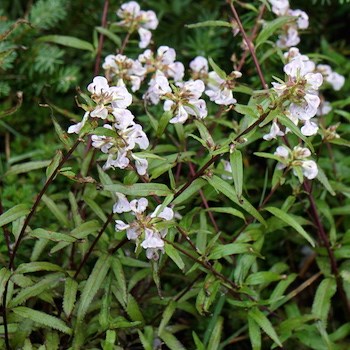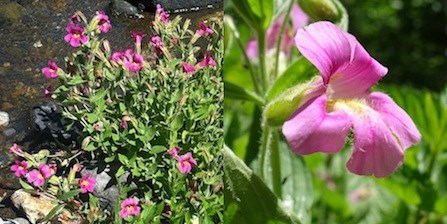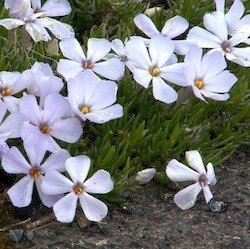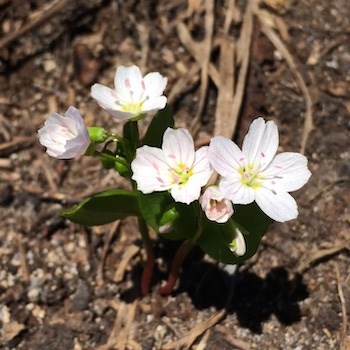|
Full resolution versions of wildflower photos available on flickr. 
NPS, Steve Redman Elephant's HeadPedicularis groenlandica A species of lousewort; grows to 8-24 inches (20-60 cm) tall, with mostly basal leaves with slender toothed lobes. The flowers have a distinctive beak that curves down and out like the trunk of an elephant. Common in wet meadows. 
NPS Photo Lousewort, Bird's BeakPedicularis ornithorhyncha This shorter flower grows to about 4-8 inches (10-20 cm) tall, with narrow, toothed, lobed leaves. The pink flowers are in dense clusters, and the top petal has a noticeable "beak-like" bent tube shape. Common in meadows and moist slopes throughout the park, between 6,000 and 7,000 feet (1,800-2,100 m). 
NPS Photo Lousewort, SickletopPedicularis racemosa This lousewort stands out by having toothed, unidivided leaves, compared to the separated lobed leaves of other lousewort species. Flowers are pink to purple with a strongly curved upper lip and broad lower lip. Common in subalpine meadows between 3,000-6,000 feet (900 -1,800 m). Also known as Ram's Horn Lousewort. 
NPS Photo Mapleleaf CurrantRibes acerifoliumThis shrub has maple-shaped leaves with 5-7 rounded, finely-toothed lobes. Each drooping cluster of flowers has about ten small blooms with greenish-red petals, that form small, black berries. Common in subalpine regions of the park, typically above 5,000 feet (1,500 m). 
NPS, Janet Killam Moss CampionSilene acaulis Forming flat cushions, this alpine plant has small, pointed, dense basal leaves and pink, lilac, or pale purple flowers. More common on the east side of the park, it grows on moraines, talus slopes, and rocky ridges between 6,000 to 8,000 feet (1,800-2,400 m). 
NPS, Chris Roundtree Paintbrush, MagentaCastilleja parviflora Easily identifiable by it's bright pink "magenta" color, this paintbrush is one of many species of paintbrush found in the park. Plant grows to about 6-12 inches (15-30 cm) tall, and leaves have 1-2 slender lobes. Abundant in subalpine meadows, particularly in the Sunrise area. 
NPS Photo Paintbrush, ScarletCastilleja miniata Very common (also known as "common red paintbrush"), mostly found above 5,000 feet (1,524 m). This paintbrush stands 8-16 inches (20-40 cm) tall with lance-shaped leaves. The leaves are a good way to distinguish this paintbrush from other paintbrush species, which have lobed leaves. 
NPS Photo Penstemon, CliffPenstemon rupicola Similar to Menzie's penstemon, this plant forms low, ground-covering mats. However, Menzie's penstemon flowers are blue-violet, while cliff penstemon has deep pink to red flowers. The grey-green leaves are oval-shaped, toothed, and finely-hairy. Common on rocky, talus slopes between 5,000-8,000 ft (1,500-2,500 m), though occasionally found at lower elevations. 
NPS Photo Pink MonkeyflowerMimulus lewisii Also known as Lewis's monkeyflower, this plant forms clumps of stems 12-24 inches (30-60 cm) tall, with oval, toothed leaves. It is found along streams, springs, and wet meadows throughout the park. 
NPS Photo Pink Mountain HeatherPhyllodoce empetriformis Forms low, branched mats with stems 4-16 inches (10-40 cm) tall and covered with alternating, needle-like evergreen leaves. Common in subalpine meadows between 5,000-8,000 feet (1,500-2,400 m). 
NPS Photo Rosy SpireaSpirea splendens A shrub, 12-40 inches (30-100 cm) tall, with elliptical, toothed leaves and dense clusters of rose pink flowers. Commonly found in the park at the margins of lakes and in wet meadows. 
NPS Photo Saxifrage, LeatherleafLeptarrhena pyrolifolia 
NPS Photo Spreading PhloxPhlox diffusa As indicated by its name, this plants spreads widely along the ground, and is common along roadsides, rocky ridges, and talus slopes. Leaves are narrow and less than an inch long (1-1.5 cm). Flowers are tinged blue when initially opening, then transition to pink-white as the blossom ages. 
NPS Photo Spring-Beauty, WesternClaytonia lanceolara var. lanceolata 
NPS Photo Subalpine DaisyErigeron peregrinus Very common in subalpine meadows, with spoon-shaped basal leaves and unbranched stems 12-24 inches (30-60 cm) in height. It is easy to confuse this flower with the alpine aster (Oresostemma apligenum), but the aster has fewer petals and appears more purplish in color, while the daisy has many layered petals ringing the flower head. Return to Wildflower Guide |
Last updated: August 13, 2025
